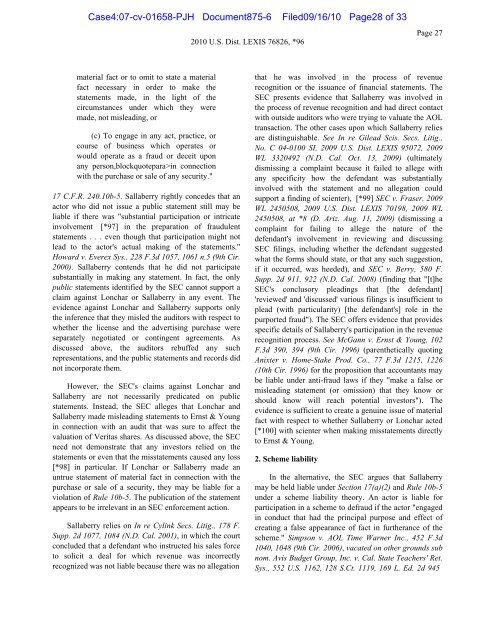exhibit 2 - SAP Lawsuit Portal
exhibit 2 - SAP Lawsuit Portal
exhibit 2 - SAP Lawsuit Portal
Create successful ePaper yourself
Turn your PDF publications into a flip-book with our unique Google optimized e-Paper software.
Case4:07-cv-01658-PJH Document875-6 Filed09/16/10 Page28 of 33<br />
material fact or to omit to state a material<br />
fact necessary in order to make the<br />
statements made, in the light of the<br />
circumstances under which they were<br />
made, not misleading, or<br />
(c) To engage in any act, practice, or<br />
course of business which operates or<br />
would operate as a fraud or deceit upon<br />
any person,blockquotepara>in connection<br />
with the purchase or sale of any security."<br />
17 C.F.R. 240.10b-5. Sallaberry rightly concedes that an<br />
actor who did not issue a public statement still may be<br />
liable if there was "substantial participation or intricate<br />
involvement [*97] in the preparation of fraudulent<br />
statements . . . even though that participation might not<br />
lead to the actor's actual making of the statements."<br />
Howard v. Everex Sys., 228 F.3d 1057, 1061 n.5 (9th Cir.<br />
2000). Sallaberry contends that he did not participate<br />
substantially in making any statement. In fact, the only<br />
public statements identified by the SEC cannot support a<br />
claim against Lonchar or Sallaberry in any event. The<br />
evidence against Lonchar and Sallaberry supports only<br />
the inference that they misled the auditors with respect to<br />
whether the license and the advertising purchase were<br />
separately negotiated or contingent agreements. As<br />
discussed above, the auditors rebuffed any such<br />
representations, and the public statements and records did<br />
not incorporate them.<br />
However, the SEC's claims against Lonchar and<br />
Sallaberry are not necessarily predicated on public<br />
statements. Instead, the SEC alleges that Lonchar and<br />
Sallaberry made misleading statements to Ernst & Young<br />
in connection with an audit that was sure to affect the<br />
valuation of Veritas shares. As discussed above, the SEC<br />
need not demonstrate that any investors relied on the<br />
statements or even that the misstatements caused any loss<br />
[*98] in particular. If Lonchar or Sallaberry made an<br />
untrue statement of material fact in connection with the<br />
purchase or sale of a security, they may be liable for a<br />
violation of Rule 10b-5. The publication of the statement<br />
appears to be irrelevant in an SEC enforcement action.<br />
Sallaberry relies on In re Cylink Secs. Litig., 178 F.<br />
Supp. 2d 1077, 1084 (N.D. Cal. 2001), in which the court<br />
concluded that a defendant who instructed his sales force<br />
to solicit a deal for which revenue was incorrectly<br />
recognized was not liable because there was no allegation<br />
2010 U.S. Dist. LEXIS 76826, *96<br />
that he was involved in the process of revenue<br />
recognition or the issuance of financial statements. The<br />
SEC presents evidence that Sallaberry was involved in<br />
the process of revenue recognition and had direct contact<br />
with outside auditors who were trying to valuate the AOL<br />
transaction. The other cases upon which Sallaberry relies<br />
are distinguishable. See In re Gilead Scis. Secs. Litig.,<br />
No. C 04-0100 SI, 2009 U.S. Dist. LEXIS 95072, 2009<br />
WL 3320492 (N.D. Cal. Oct. 13, 2009) (ultimately<br />
dismissing a complaint because it failed to allege with<br />
any specificity how the defendant was substantially<br />
involved with the statement and no allegation could<br />
support a finding of scienter), [*99] SEC v. Fraser, 2009<br />
WL 2450508, 2009 U.S. Dist. LEXIS 70198, 2009 WL<br />
2450508, at *8 (D. Ariz. Aug. 11, 2009) (dismissing a<br />
complaint for failing to allege the nature of the<br />
defendant's involvement in reviewing and discussing<br />
SEC filings, including whether the defendant suggested<br />
what the forms should state, or that any such suggestion,<br />
if it occurred, was heeded), and SEC v. Berry, 580 F.<br />
Supp. 2d 911, 922 (N.D. Cal. 2008) (finding that "[t]he<br />
SEC's conclusory pleadings that [the defendant]<br />
'reviewed' and 'discussed' various filings is insufficient to<br />
plead (with particularity) [the defendant's] role in the<br />
purported fraud"). The SEC offers evidence that provides<br />
specific details of Sallaberry's participation in the revenue<br />
recognition process. See McGann v. Ernst & Young, 102<br />
F.3d 390, 394 (9th Cir. 1996) (parenthetically quoting<br />
Anixter v. Home-Stake Prod. Co., 77 F.3d 1215, 1226<br />
(10th Cir. 1996) for the proposition that accountants may<br />
be liable under anti-fraud laws if they "make a false or<br />
misleading statement (or omission) that they know or<br />
should know will reach potential investors"). The<br />
evidence is sufficient to create a genuine issue of material<br />
fact with respect to whether Sallaberry or Lonchar acted<br />
[*100] with scienter when making misstatements directly<br />
to Ernst & Young.<br />
2. Scheme liability<br />
Page 27<br />
In the alternative, the SEC argues that Sallaberry<br />
may be held liable under Section 17(a)(2) and Rule 10b-5<br />
under a scheme liability theory. An actor is liable for<br />
participation in a scheme to defraud if the actor "engaged<br />
in conduct that had the principal purpose and effect of<br />
creating a false appearance of fact in furtherance of the<br />
scheme." Simpson v. AOL Time Warner Inc., 452 F.3d<br />
1040, 1048 (9th Cir. 2006), vacated on other grounds sub<br />
nom. Avis Budget Group, Inc. v. Cal. State Teachers' Ret.<br />
Sys., 552 U.S. 1162, 128 S.Ct. 1119, 169 L. Ed. 2d 945


